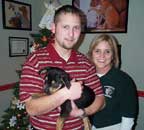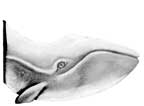|
Dock of the Bay
 Old-Fashioned Streets Heighten Holiday Fun Old-Fashioned Streets Heighten Holiday Fun
Shopping Downtown Annapolis Fills the Christmas Bill
The accents are more Baltimore than old English.
Petticoats are replaced by pea coats, and bonnets by baseball caps.
The cobblestone is not so worn, and the carriages delivering their wares are horseless.
These differences don’t keep shoppers in downtown Annapolis from feeling, however briefly, that they’ve stepped back in time to merry old England.
These quaint reminders of a passed time aren’t accidental. In the past four years the city of Annapolis and the state of Maryland have spent nearly $19 million tearing up West Street from Gateway Circle to Church Circle. As had been done on Main Street in the previous decade, bricks replaced asphalt on streets and concrete on sidewalks. Old-fashioned light posts in the style of gas lamps went up, giving West Street, and the rest of downtown, the feel of a 19th century English town.
That old-world charm makes downtown Annapolis a destination as well as a market place.
“I don’t get much shopping done,” said Ruth Johansen of Baltimore as she tried on hats at Hats in the Belfry on Main Street as Christmas approached. “But I come to take a nice walk, get a bite to eat and browse the stores. It’s like stepping back in time.”
For Johansen and long-time friend Barbara Derring, the 45-minute drive from their homes in the Hamden neighborhood of Baltimore is more vacation than shopping excursion.
“We’re not rich,” Derring says. “By the time we pay for gas and lunch, there’s not much left for Christmas shopping.”
It’s not that the women are poor. Johansen is a retired schoolteacher and Derring retired from the phone company.
“We have children, grandchildren, nieces and nephews to shop for,” Johansen said. “So our few dollars have to go a long way.”
Their dollars don’t go a long way in downtown Annapolis, the women claim.
“Most of the shops down here are out of our price range,” said Derring, who believes her money goes farther at discount stores or malls. “I wish we could afford a lot of these shops.”
But prices haven’t slowed business at Oceans II.
“We’ve been pretty steady this season,” said David Seel who works behind the counter at the Main Street record store. “Midnight Madness [Annapolis’ midnight shopping night] was a bit off because of the rain, but there’s been continuity throughout the season; especially Saturday and Sunday.”
Business is brisk for Mauriy Chaput as well. “I’m tickled by the generosity of people,” he said.
Because of the cold weather, foot traffic is slow, but that doesn’t mean the Arnold man isn’t kept busy at City Dock as a bell-ringer for the Salvation Army.
On Maryland Avenue, Nicole Johnson of Annapolis shopped antique shops. “It’s a little tough to find the right gifts, but I figure it’s worth the effort,” she said.
The 28-year-old newlywed wants to find the perfect gift for her in-laws. “We’ve been together for a few years,” she said of her husband, Victor. “But now I want them to be sure to know their son married the right girl.”
Victor rolls his eyes. “She doesn’t understand they love her regardless of what she buys them,” he said.
The Johnsons agree they could find gifts for their family anywhere, but they find something special shopping downtown. “We really can’t find the Christmas spirit at the malls or Target,” said Nicole. “Down here the lights are up, you can walk the streets, and it seems like what Christmas was supposed to be. I feel like I’m in a Norman Rockwell painting.”
That holiday feel is deliberate. The city bags parking meters from Thanksgiving through New Year’s to encourage residents and visitors to shop downtown.
After a year when local business often attacked city mayor Ellen Moyer for lack of support, the mayor’s office is pushing city programs that business can live with.
“We are encouraging shopping in the short run,” said Hardesty. “But in the long run we are planning for a more vigorous and vibrant downtown sector that has on-going vitality rather than seasonal.”
At Alpaca International on Main Street, business is up 20 percent from last year.
But owner Pete Cotegreave doesn’t credit the mayor’s office. He says his success is due to wholesaling and a steady stream of repeat customers.
After a year doing business in downtown Annapolis, Cotegreave is profitable and satisfied. “I love coming to work downtown. It has all the charm. It’s a great little town,” he said.
Johansen and Derring agree.
“It’s like walking through a European village,” Johansen said.
“Yes,” said Derring. “And we can’t afford it there either.”
—Louis Llovio
 |
| Rep. Wayne Gilchrest called for action “to actually restore the Bay – so the Bay doesn’t leak away.” |
Straight to the Source
Legislators Appeal to the Experts for Bay Updates and Advice
Seeking the very best in scientific sources for Bay decisions, Congressman Wayne Gilchrest gathered leading Bay experts and scientific directors in Annapolis this week to recommend action. Sen. Barbara Mikulski and Virginia Rep. Robert Scott from the Chesapeake Bay Task Force attended the subcommittee on Fisheries Conservation, Wildlife and Oceans field hearing to question Bay experts.
“We’d like to have an understanding that would develop programs to actually restore the Bay — so the Bay doesn’t leak away,” Gilchrest said.
Testimonies ranged from broad — improving the overall health of the Bay — to specific — management plans for menhaden.
“The Bay is like an overfertilized and undergrazed pasture,” said Thomas Fisher, professor at Cambridge’s Horn Point Laboratory, who recommended more funding for winter cover crops, stream buffers of at least 30 feet, better animal manure management and a cap on maximum discharge of nitrogen and phosphorus from water treatment plants.
Oysters were a hot topic on the agenda. Native oysters were once a keystone species — an estimated 4.8 billion reside in the Bay — one-100th of what we need, said Mark Luckenbach, director of Virginia Institute of Marine Science’s Eastern Shore Laboratory. Scientists cautioned lawmakers about hurrying to introduce the Asian oyster ariakensis.
“Human pathogen data hasn’t been included in environmental risk assessments on the Asian oyster,” said Jan Powell of the University of Maryland. Such diseases that humans can contract, like bloodstream infections by vibrio vulnificus, are widespread in Asia. Powell advised research on whether Asian oysters in Chesapeake Bay could also harbor such diseases.
Luckenbach estimated the full range of testing would take three to seven years; last year the National Academy of Science suggested a minimum of five years.
We shouldn’t expect oysters to filter the Bay alone, the experts said. The little bait fish menhaden also filter feed, and they too need attention.
Experts also called for less bureaucracy and more rules and regulations on polluting.
“Under-funded voluntary programs are insufficient to bring about the widespread behavioral changes that would be necessary to restore the Bay,” said U.S. Naval Academy political science professor Howard Ernst, author of Chesapeake Bay Blues.
—Carrie Steele
 |
photo by Carrie Steele
James and Bonnie Brown consider adopting a young pup at Fishing Creek Kennel’s Home 4 the Holidays 48-hour open house. |
There’s No Place Like Homes
Long Wish Lists at Area Animal Shelters
Local humane societies and animal shelters aren’t appealing to Santa for Christmas. They’re asking you to fulfill their wants and needs. What they want most is to find good homes for animals. In the meantime, the animals in their care need help eating and staying warm.
These non-profits reach deep into their pockets to provide for pets without homes year round, but during the holidays, they especially look for community support to keep animals off the streets.
Anne Arundel County’s leading animal welfare organization, the SPCA of Anne Arundel County, depends on donations, as well as a few grants, to keep their some 100 dogs, 200 cats and various rabbits and guinea pigs warm and dry. The holidays fill their stocking with everyday needs.
“During the holidays, we get lots of donations of supplies, like toys, towels and blankets,” said Sue Beatty, SPCA executive director.
In Calvert County, animal welfare organizations abound.
One, the Humane Society of Calvert County, is counting on the season of giving to help earn — and double — a much-needed matching grant for $20,000 to pay off a renovations debt.
Though paying off the renovation weighs heavy on the minds of the Humane Society volunteers, they also welcome donations to ease their operating costs. With 95 animals in their care — 69 dogs, 25 cats and a horse —money is always scarce. Twenty-two of their dogs reside in the Fishing Creek Kennel; the other dogs, the cats and the horse board in foster homes. Their year-round wish list includes items like canned dog food, dog beds and cat carriers.
“Our vet bill alone was $7,000 last month,” says Sally Lounsbury of Calvert’s Humane Society. They’re counting on holiday generosity before their slow season. “January through April is a really slow time,” said Lounsbury. “We don’t get many adoptions or donations.”
Another Calvert animal shelter is celebrating its first Christmas after opening its doors to homeless animals this summer. The Calvert Animal Welfare League has two large items on its wish list: a commercial clothes washer and a generator.
“Of course, we always need donations to pay the bills and food for the animals,” says the League’s Tereza Marks. “We also need volunteers to help with everything from cleaning cages to helping show animals to potential adoptors.”
In this first Christmas, the Welfare League has noticed a rise in adoptions: “People adopted several dogs last week and a few cats and kittens,” Marks says, which makes room for incoming pets. “We can only take in as many animals as we can care for.”
Though adoptions top the wish lists of animal shelters and humane societies, they only want to place their animals in homes that are ready to dedicate time, money and care to a pet.
To help match companion animals with responsible homes, The Humane Society at Fishing Creek Kennel stayed open 48 straight hours last weekend as part of a national Home 4 the Holidays campaign. With holiday treats in their festively decked office, volunteers at the kennel showed off their dogs to potential adoptive families.
“We’re doing this to help orphan animals find a home,” said volunteer Sherry Pinson, just after the weekend’s kickoff. “We even have one dog scheduled to be adopted at midnight.”
Ten dogs, two cats and two guinea pigs found new homes during the holiday adoption campaign, with six applications still pending.
Still, thousands of pure and mixed breed dogs and cats await adoption in local shelters. Instead of purchasing a pet from a pet store or from a breeder, save an animal from the shelter, says Marks of the Calvert Animal Welfare League.
But if it’s a gift animal, make sure it’s a wanted gift. Unless you’re dedicated to providing the time and money that companion animals require, don’t adopt.
“We recommend never giving a puppy as a surprise,” SPCA’s Beatty said. “If someone’s interested in getting an animal, they should be involved with the selection.”
—Carrie Steele
Ask the Plant Professor
Creatures Great and Small
Q Do those ladybugs that get in the house bite? My husband says they’re good, but I’m certain one bit me.
A Asian lady beetles, like all lady beetles, are predators of insects. In order to eat insects, they have biting mouthparts. So, though they do not inject a poison or draw blood like a mosquito, it’s possible for them to nip your skin when being removed from the house. Use a vacuum or dustpan and broom to remove clusters of lady beetles. A tissue works well for picking up one or two.
Q Do you have any suggestions on how to keep dogs from jumping inside my compost bin and rolling around in the compost?
A Dogs in general seem to enjoy the smell of decomposing material, especially dead animals. Avoid animal proteins — e.g. meat, eggs or dairy products — in compost. Then, to keep your dogs out of the bin, erect higher sides and/or cover with chicken wire.
Ask the Plant and Pest Professor is compiled from questions sent to the website of the Home and Garden Information Center, part of Maryland Cooperative Extension, an educational outreach of the University of Maryland. Ask a home gardening or pest control question and find other help: 800-342-2507 (Mon.-Fri. 8am-1pm) • www.hgic.umd.edu.
Way Downstream
In Annapolis, early word is that Maryland’s 2004 crab harvest rebounded slightly — between 27 million to 29 million pounds, up from 25 million last year — according to a preliminary tally by Department of Natural Resources. The harvest was the best in five years, but it’s still roughly half the harvests of a decade ago …
 In Virginia, the Chesapeake Bay Foundation is suing to overturn a State Water Control Board permit that allows Philip Morris to release 167,000 pounds of nitrogen pollution into the James River annually from a plant near Chester. In court, the cigarette-maker argued last week that the foundation has no standing to sue because it isn’t directly affected by the pollution … In Virginia, the Chesapeake Bay Foundation is suing to overturn a State Water Control Board permit that allows Philip Morris to release 167,000 pounds of nitrogen pollution into the James River annually from a plant near Chester. In court, the cigarette-maker argued last week that the foundation has no standing to sue because it isn’t directly affected by the pollution …
In Kenya, Nobel Peace Prize winner Wangari Maathai has a solution for what ails the planet: planting trees. Maathai, Africa’s first female Nobel laureate, organized plantings of 30 million trees on her continent. She suggests starting campaigns around the world at Easter, noting that a tree had to be cut to provide Christ’s wooden cross …
Our Creature Feature comes from the Northern Pacific Ocean, where for more than a decade now the U.S. Navy sub-tracking monitors have picked up sounds like no others. They belong to a lone whale, singing at a high-pitched frequency that matches no known species of whale on earth.
Nor, does this strange creature of the sea follow migration patterns of other whales, although it is a baleen, a group that includes blue whales, fin whales and humpbacks. How unusual is it? Most whales’ calls register at between 15 and 20 hertz; the mysterious lone whale makes sounds at 52 hertz.
to the top
|


 Old-Fashioned Streets Heighten Holiday Fun
Old-Fashioned Streets Heighten Holiday Fun


 In Virginia, the Chesapeake Bay Foundation is suing to overturn a State Water Control Board permit that allows Philip Morris to release 167,000 pounds of nitrogen pollution into the James River annually from a plant near Chester. In court, the cigarette-maker argued last week that the foundation has no standing to sue because it isn’t directly affected by the pollution …
In Virginia, the Chesapeake Bay Foundation is suing to overturn a State Water Control Board permit that allows Philip Morris to release 167,000 pounds of nitrogen pollution into the James River annually from a plant near Chester. In court, the cigarette-maker argued last week that the foundation has no standing to sue because it isn’t directly affected by the pollution …